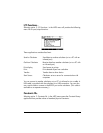
Page E-1
Appendix E
The Selection Tree in the Equation Writer
The expression tree is a diagram showing how the Equation Writer interprets an
expression. The form of the expression tree is determined by a number of rules
known as the hierarchy of operation. The rules are as follows:
1. Operations in parentheses are executed first, from the innermost to the
outermost parentheses, and from left to right in the expression.
2. Arguments of functions are executed next, from left to right.
3. Functions are executed next, from left to right.
4. Powers of numbers are executed next, from left to right.
5. Multiplications and divisions are executed next, from left to right.
6. Additions and subtraction are executed last, from left to right.
Execution from left to right means that, if two operations of the same hierarchy,
say two multiplications, exist in an expression, the first multiplication to the left
will be executed before the second, and so on.
Consider, for example, the expression shown below in the equation writer:
The insertion cursor () at this point is located to the right of the 2 in the
argument of the SIN function in the denominator. Press the down arrow key
˜to trigger the clear, editing cursor () around the 2 in the denominator.
Next, press the left arrow key š, continuously, until the clear, editing cursor is
around the y in the first factor in the denominator. Then, press the upper-arrow
key to activate the selection cursor () around the y. By pressing the upper
arrow key —, continuously, we can follow the expression tree that will take
use from the y to the completion of the expression. Here is the sequence of
operations highlighted by the upper arrow key—:


















